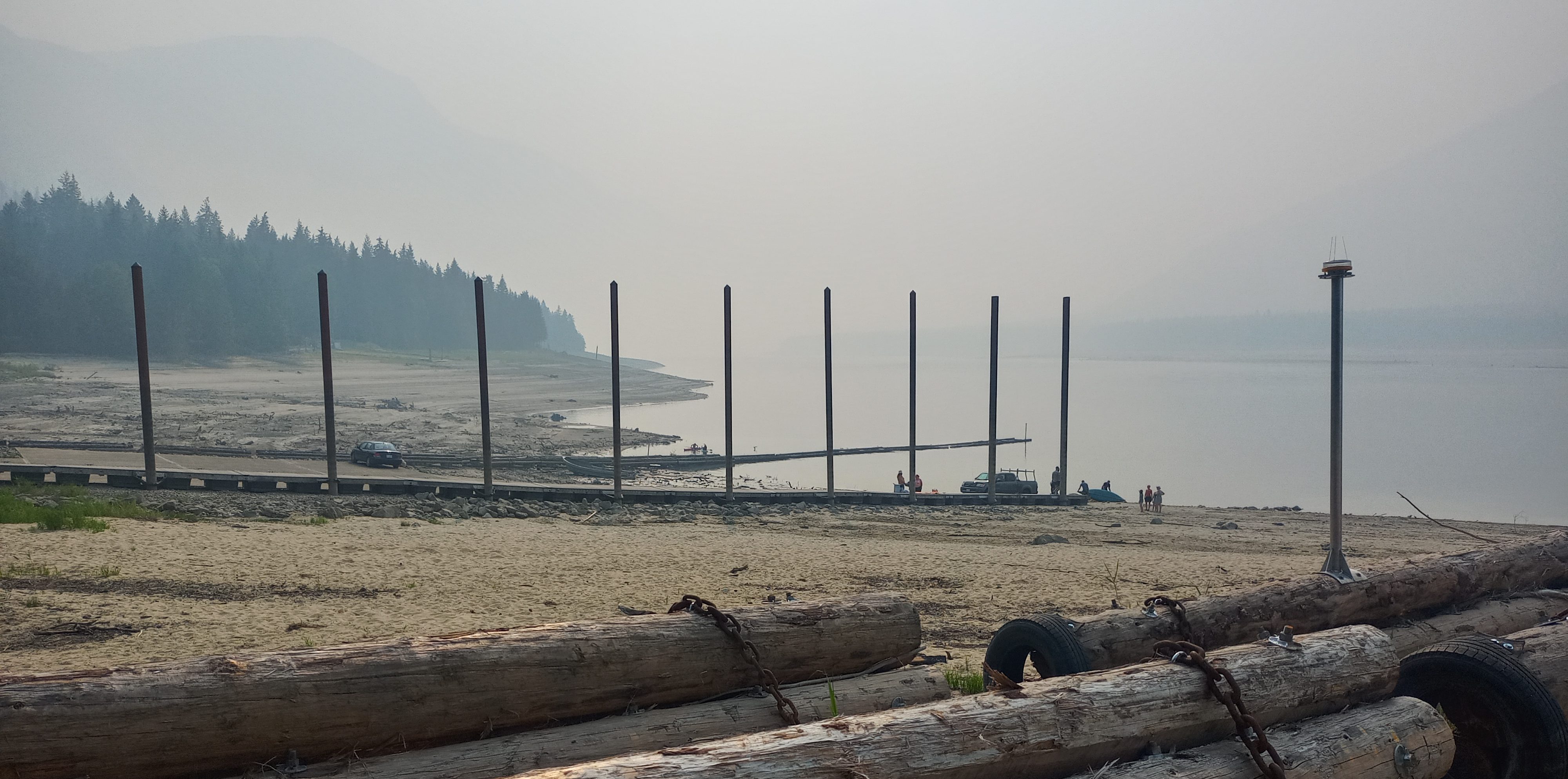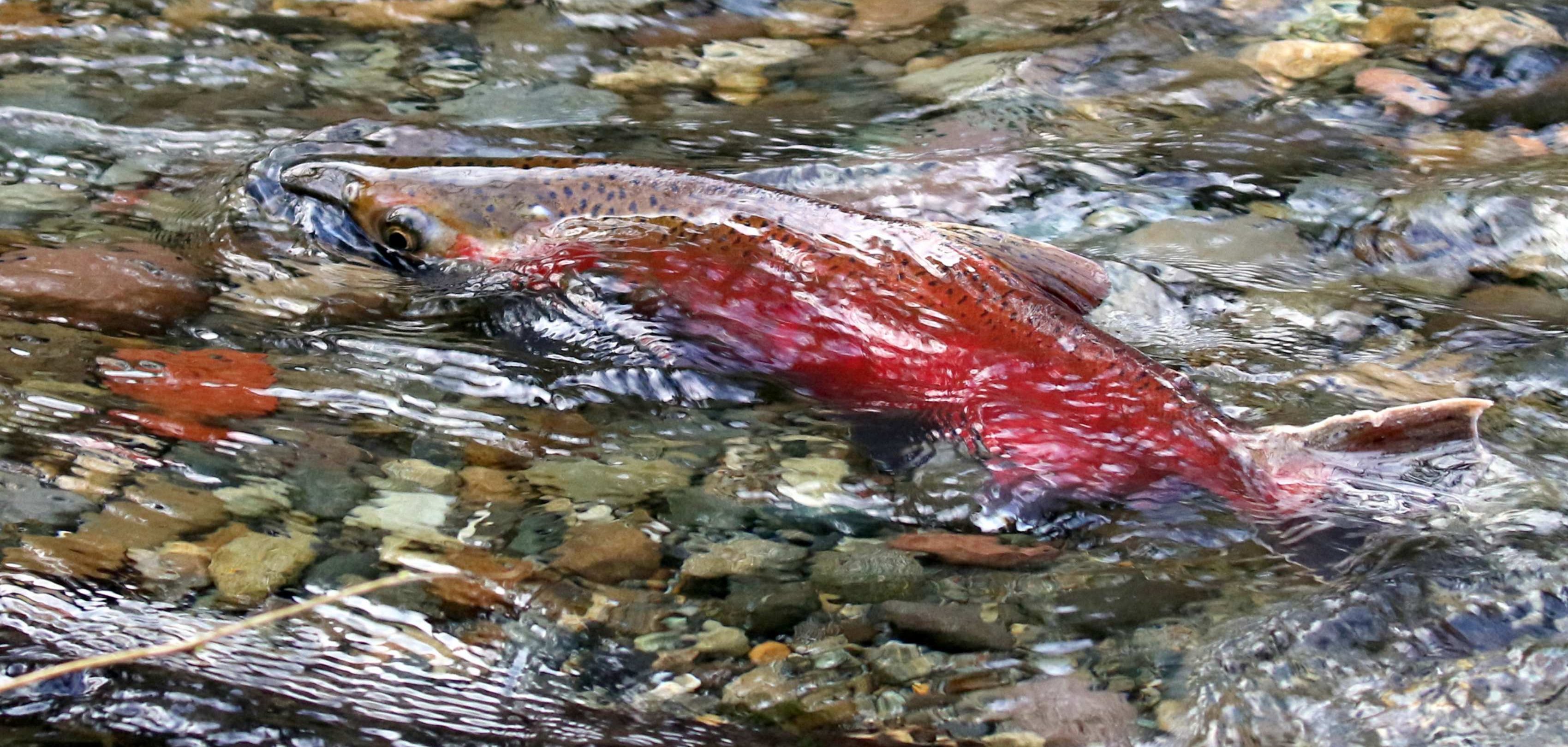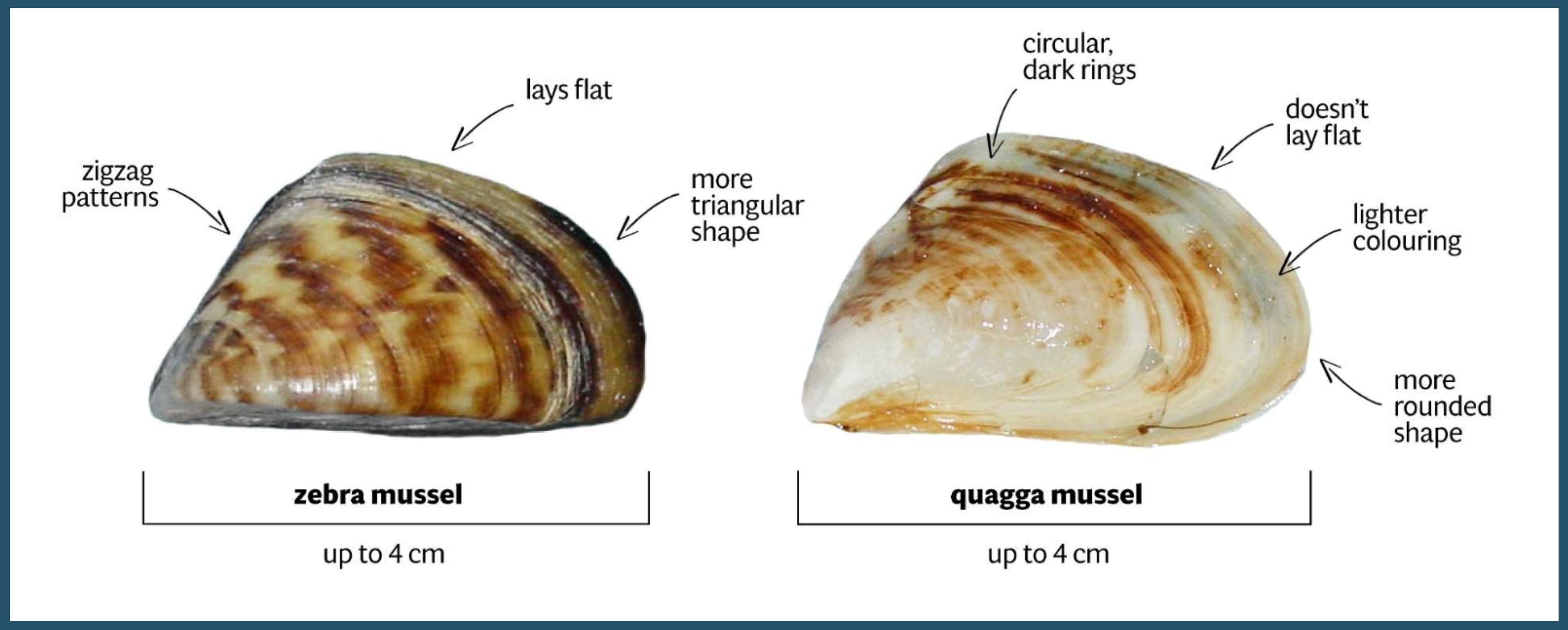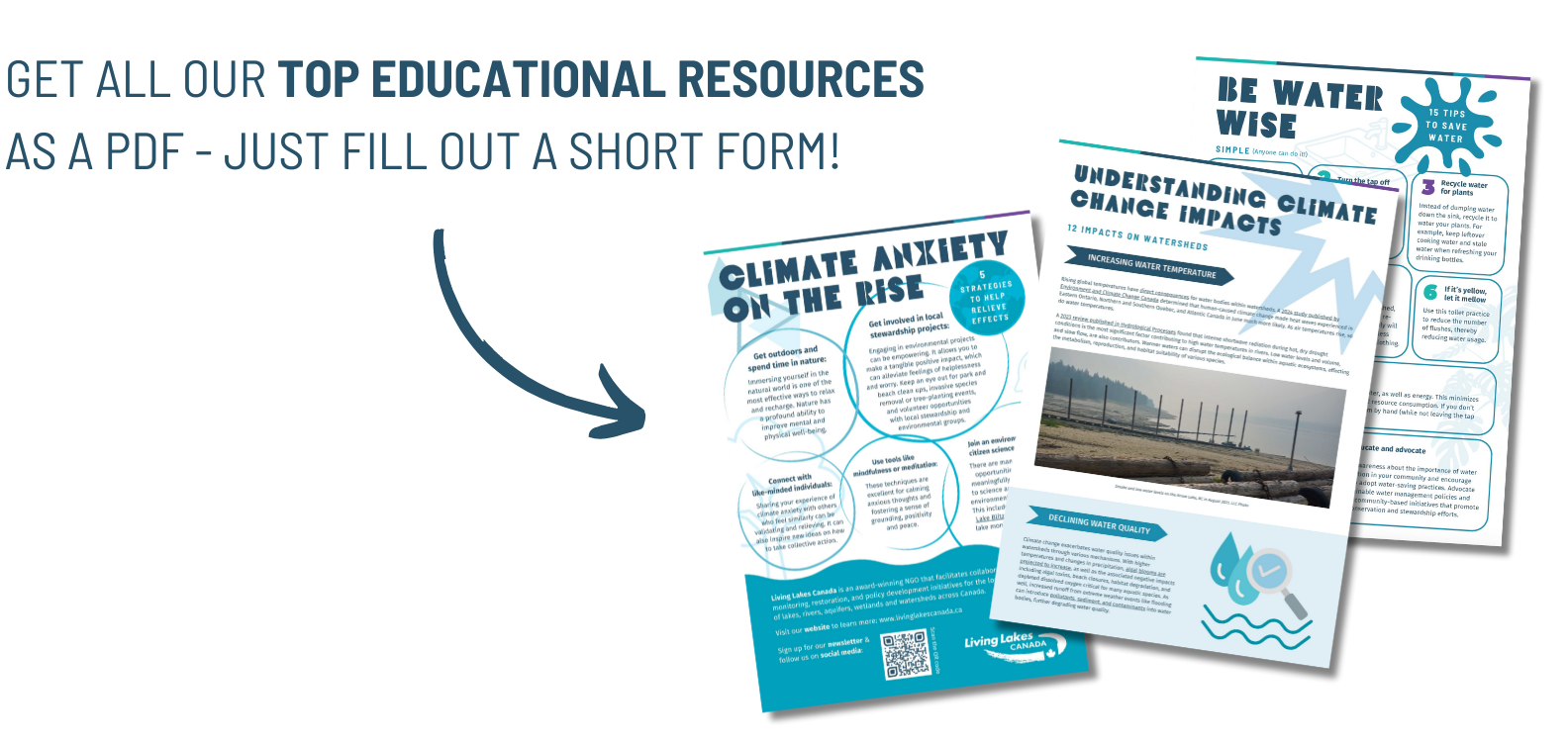Understanding Climate Change Impacts
12 Impacts on Watersheds
Watersheds—an area of land that channels rainfall, snowmelt, and runoff into a common body of water—are experiencing profound climate change impacts. From rising water temperatures to declining snowpacks and glaciers and the spread of invasive species, these changes are fundamentally altering how watersheds function and affecting the ecosystems they support.
Here are 12 top climate change impacts on watersheds:
Increasing Water Temperature
Rising global temperatures have direct consequences for water bodies within watersheds. A 2024 study published by Environment and Climate Change Canada determined that human-caused climate change made heat waves experienced in Eastern Ontario, Northern and Southern Quebec, and Atlantic Canada in June much more likely. As air temperatures rise, so do water temperatures.
A 2023 review published in Hydrological Processes found that intense shortwave radiation during hot, dry drought conditions is the most significant factor contributing to high water temperatures in rivers. Low water levels and volume, and slow flow, are also contributors. Warmer waters can disrupt the ecological balance within aquatic ecosystems, affecting the metabolism, reproduction, and habitat suitability of various species.

Declining Water Quality
Climate change exacerbates water quality issues within watersheds through various mechanisms. With higher temperatures and changes in precipitation, algal blooms are projected to increase, as well as the associated negative impacts including algal toxins, beach closures, habitat degradation, and depleted dissolved oxygen critical for many aquatic species. As well, increased runoff from extreme weather events like flooding can introduce pollutants, sediment, and contaminants into water bodies, further degrading water quality.
Changes in Aquatic Species Behaviour and Populations
Climate change is causing significant shifts in the distribution and behavior of aquatic species within watersheds. Some species may migrate to cooler waters, while others face habitat loss or increased competition for resources. In recent years, British Columbia has witnessed many mass deaths of cold-water fish due to extreme drought and high temperatures.
These changes can disrupt food webs, alter ecosystem functions, and lead to declines in biodiversity. Freshwater biodiversity is disproportionately at risk to climate change impacts. While freshwater ecosystems cover only 0.8% of Earth’s surface, they support around 6% of all species worldwide.

Spreading of Invasive Species
Warming temperatures, more frequent extreme weather events, and changing hydrological cycles create favourable conditions for the spread of invasive species in watersheds. Invasive species of aquatic plants, fish, and invertebrates can outcompete native species, degrade water quality, and disrupt ecosystem dynamics. A 2023 study published in Perspectives in Ecology and Conservation found that the spread of invasive species is more economically devastating than natural disasters, including storms, floods and wildfires.
An example of a prominent invasive species are Zebra and Quagga Mussels that are now found throughout Ontario, Quebec, and Manitoba. They deplete food for native species, overtake fish spawning areas and beaches, and easily spread between water bodies by latching onto boats.
Tip: For water recreationists, Clean Drain Dry is a simple step to help protect waterways from the spread of invasive species.
Shifting Hydrological Cycles
Climate change alters precipitation patterns, leading to more frequent and intense droughts or floods in many regions. These changes in the global hydrological cycle impact watershed ecosystems by altering the distribution and amount of water, seasonal changes, and timing of water storage. These changes impact streamflow, groundwater recharge, water storage capacity, precipitation and evapotranspiration. Shifts in water availability and timing can affect the health and resilience of aquatic habitats and species.
Tip: In order to plan for future land use and ensure sustainable water management, it’s important to understand how much water is currently available across watersheds, and how climate change will continue to impact the water cycle.
Glacial Retreat
Glaciers store vast amounts of freshwater as ice and, as they melt, replenish rivers, streams and aquifers. Not only are glaciers receding at unprecedented rates due to rising temperatures, a 2022 study published in Nature Geoscience found that Earth’s glaciers may have less ice than previously estimated. This means these reserves of water could dry up sooner than expected.
Communities reliant on glacial meltwater face increased water insecurity, highlighting the urgent need for adaptation strategies. For example, 20 million Peruvians are either directly or indirectly reliant on glacial water, however the country has already lost 56% of its tropical glaciers in the last 6 decades due to climate change.

Diminishing Snowpacks
Snowpacks are also crucial reservoirs of water in mountainous watersheds, but they’re at risk as temperatures rise and more precipitation falls as rain rather than snow. Reduced snow accumulation and earlier snowmelt have far-reaching consequences for water supply and timing of runoff, which can then negatively impact ecosystem health and human recreation and tourism.
A 2024 study published in Nature found that “human-caused warming has caused declines in Northern Hemisphere-scale March snowpack over the 1981-2020 period”. A 2024 global assessment published in PloS One found that “13% of all current ski areas are projected to completely lose natural annual snow cover and one fifth will experience a reduction of more than 50% by 2071-2100”.
Intensifying Drought
A 2023 study published in Nature Water confirms that human-driven climate change is amplifying the frequency and severity of droughts, as well as rainfall, in many regions. Droughts deplete surface water sources, stress aquatic habitats, and exacerbate competition for limited water resources. Changes in hydrological cycle, glacial retreat and diminishing snowpack all contribute to intensifying drought conditions.
In 2023, Canada faced one of its most severe droughts in recent history. As a result, Prairie provinces including Alberta and Saskatchewan, and British Columbia faced grasshopper infestations, damaged crops, stranded fish, historic wildfires and the quandary of selling livestock due to feed storages.
Visit Agriculture and Agri-Food Canada website to view a map of current drought conditions. The Government of BC maintains a Drought Information Portal with a Drought and Watershed Watch Map that provides drought level overviews for each major basin.
Increasing Severe Wildfires
Hotter, drier conditions driven by climate change increase the availability and dryness of wildfire fuel, and exacerbate fire behavior, leading to more severe and frequent blazes. In Canada, the 2023 wildfire season set a new record for the largest area burned in the country’s history, surpassing the previous high marks set in 1989, 1995, and 2014. It also eclipsed the 2020 Western US wildfire season, making it the most destructive in North American history. By September 5th, over 6,132 fires had ravaged 16.5 million acres, an area larger than Greece and more than double the 1989 record.
Current fire management practices are based on a diurnal fire cycle where wildfires are active during the day, and quiet at night. However, a 2023 Canadian study published in Nature found that warming temperatures are breaking down the “climatological barrier” that has typically limits wildfire burning overnight. Information about how wildfire behaviour is changing as a result of climate change is crucial for firefighting efforts to help manage wildfire spread and protect communities and important infrastructure.

Loss of Wetland Habitats
Wetland ecosystems are among the most important in regulating water resources, however they have declined by 21-35% since 1700 due to human intervention, according to a 2023 study published in Nature. Wetlands face loss and degradation through land use conversions for agriculture, resource extraction and urban development, and climate change impacts through permafrost thaw, droughts and fires.
These ecosystems provide essential functions such as water filtration, and flood and drought mitigation. They’re also home to an incredible amount of biodiversity. Wetlands, and in particular, peatlands store large amounts of carbon in their soils for millenia. But, when they’re drained, carbon and nitrogen are released as greenhouse gases in the form of carbon dioxide and nitrous oxide. Their degradation or loss reduces the resilience of watersheds and exacerbates climate change.
Disproportionate Impact on Marginalized Communities
A 2023 report by Deloitte Canada found that climate events and actions taken to mitigate climate change disproportionately impact low-income individuals and communities, with a particular focus on racialized and Indigenous groups. In the aftermath of climate catastrophes, marginalized populations may struggle to rebuild in comparison to high income communities. According to the report, “relocation can bring economic and spiritual burdens, especially for Indigenous Peoples who are deeply connected to the land” and increases the risk of physical and mental health challenges.
Challenges for Water Management
 Climate change presents significant challenges for sustainable water management within watersheds. Competing demands for water pose complex challenges for ensuring water security, ecosystem health, and human livelihoods. Adaptive management strategies are essential to address these evolving water security challenges.
Climate change presents significant challenges for sustainable water management within watersheds. Competing demands for water pose complex challenges for ensuring water security, ecosystem health, and human livelihoods. Adaptive management strategies are essential to address these evolving water security challenges.
Understanding the multifaceted impacts of climate change on watersheds is crucial for developing effective mitigation and adaptation strategies. By prioritizing conservation efforts, promoting monitoring and sustainable water management practices, and reducing emissions globally, we can work towards safeguarding the health and resilience of watershed ecosystems for current and future generations.
Tip: Living Lakes Canada’s Columbia Basin Water Monitoring Framework was featured in the Water International Journal as a “best practices” example of water governance. Learn more.
SIGN UP for Living Lakes Canada’s newsletter to stay in the flow of water news and get involved in the protection of lakes, rivers, wetlands and watersheds.
Learn more about our water science and stewardship
Columbia Basin Water Monitoring Framework
Existing water monitoring networks in B.C. are insufficient to track and understand climate impacts. The goal of the Columbia Basin Water Monitoring Framework is to establish a coordinated monitoring network to support the tracking of the effects of climate change and other impacts on water supply for communities and ecosystems. The data collected will be used to inform strategies for adaptive watershed management and freshwater stewardship in the Columbia Basin. Learn more.
Columbia Basin Groundwater Monitoring Program
Many municipalities and rural property owners rely on groundwater, yet little is known about how climate and other impacts like land use are affecting the water underground. The goal of the Columbia Basin Groundwater Monitoring Program is to increase knowledge about groundwater resources to effectively inform sustainable water management and meet the needs of people and nature. In collaboration with various partners, we’re collecting and sharing groundwater level data from 34 Volunteer Observation Wells. Learn more.
High Elevation Monitoring Program
High elevation ecosystems, which mark the headwaters of many freshwater systems in mountainous regions, are fragile environments that are especially sensitive to change. This makes them important indicators of watershed condition. The aim of Living Lakes Canada’s High Elevation Monitoring Program is to establish long-term monitoring and generate data that will lead to a better understanding of changes occuring in high elevation ecosystems and what these changes mean for the future of water supply in our study areas. Learn more.



